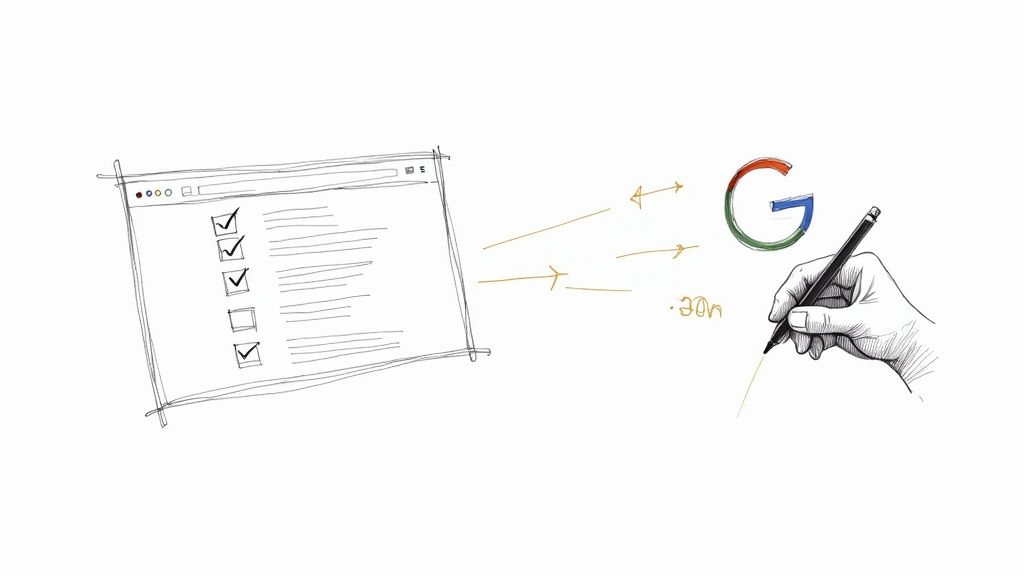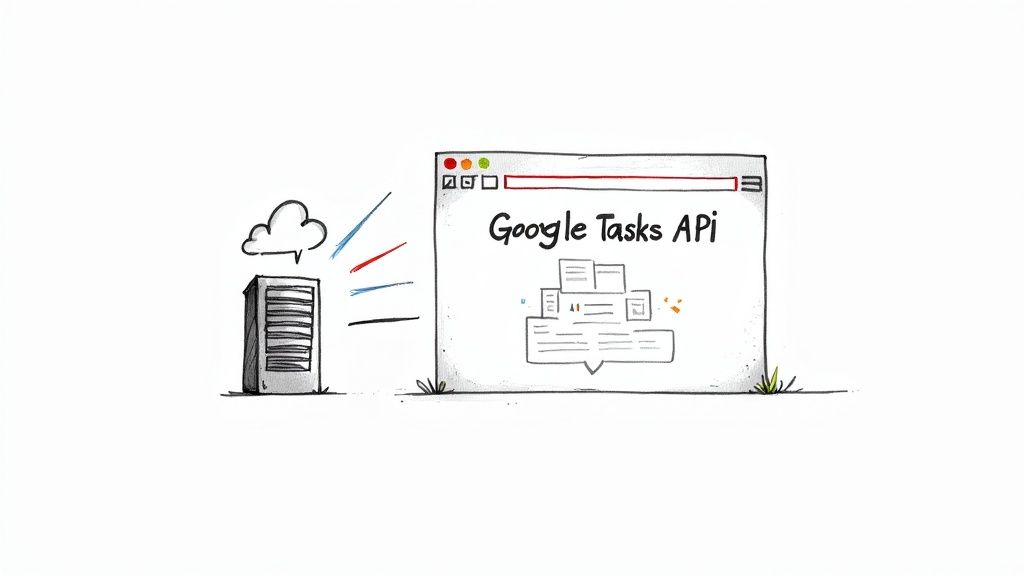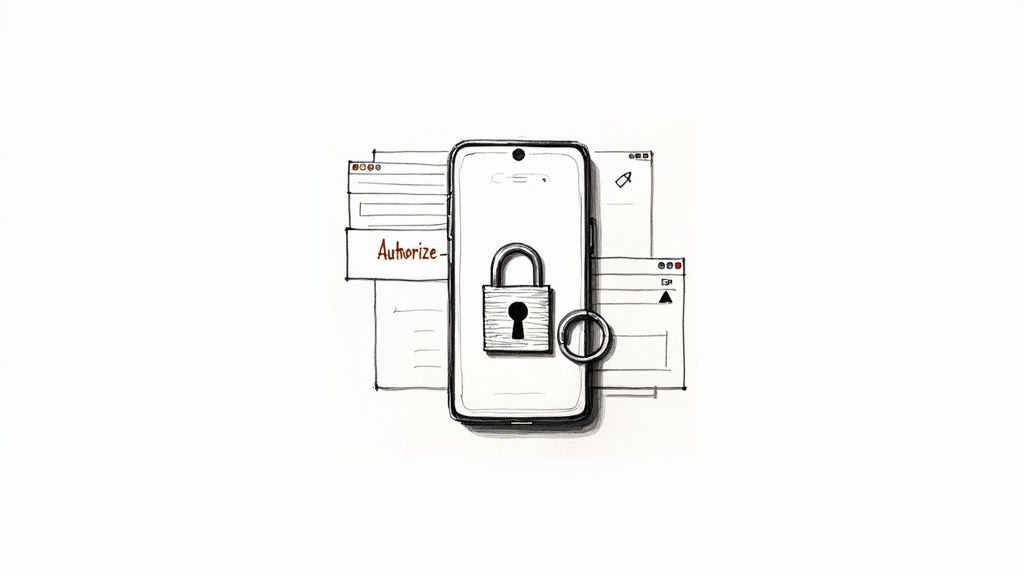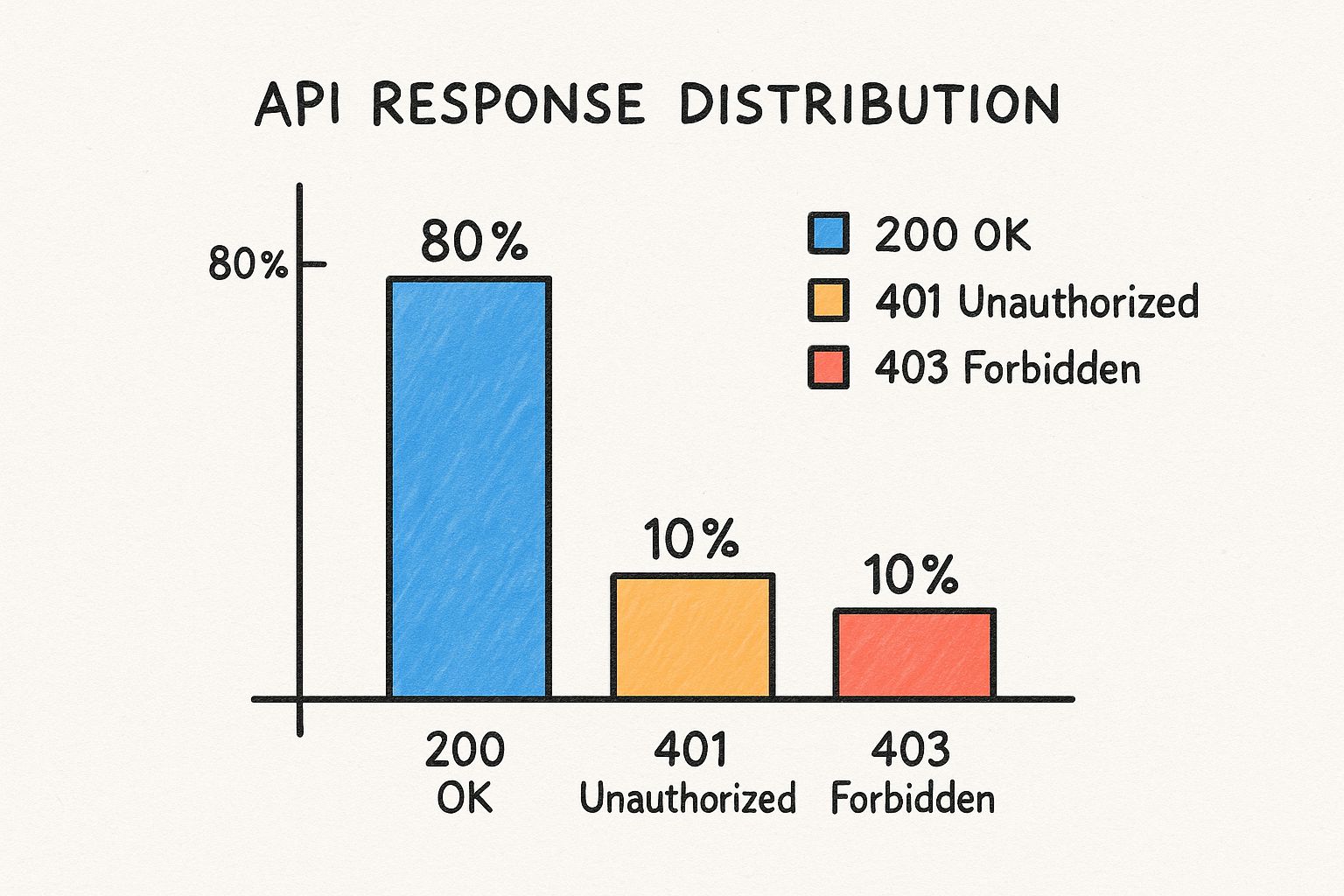
Google Tasks API Guide: Master Integration & Development
Learn how to use the Google Tasks API with expert tips on authentication, setup, and real-world applications. Boost your productivity today!

Getting Started With Google Tasks API Development

Building applications with the Google Tasks API offers a wealth of opportunities to improve productivity and streamline how we work. The journey starts with understanding the basic building blocks of this API. It centers around two core components: task lists and tasks.
Task lists act like containers for organizing individual tasks. Think of them as project categories or folders in your task management system. This inherent structure allows for effective categorization of your to-dos.
Understanding Task Lists and Tasks
Visualize task lists as folders on your computer, with individual tasks representing the files within them. You might have a task list named "Work Projects," containing tasks like "Prepare presentation" or "Schedule team meeting." Each task within a list has attributes such as a title, notes, a due date, and a completion status.
This structured data, formatted using JSON, is fundamental for interacting with the API. A solid grasp of this JSON structure is essential for efficient API interaction and will prevent hours of potential debugging later on.
The Role of the API Within the Google Ecosystem
The power of the Google Tasks API lies in its integration with the broader Google ecosystem. Its connection with services like Gmail and Google Calendar creates a smooth and unified user experience.
You can, for instance, create a task directly from an email in Gmail. Or, you can set a reminder linked to a due date in Google Calendar. All of this is possible thanks to the interconnected nature of these Google services. This integration offers significant value, enabling users to manage tasks within their established workflows.
The Google Tasks API debuted in 2011, providing developers with RESTful API endpoints for managing tasks and task lists. This represented a significant leap forward, integrating Google Tasks into web applications and granting users access to their tasks from anywhere. The API uses JSON data representation and supports multiple authentication methods, including OAuth 2.0, ensuring versatility for integration into various application types. Explore this topic further.
Setting Up for Success
Before writing any code, several key setup steps will greatly influence your long-term success. First and foremost is obtaining the required API keys and setting up the correct authentication credentials. This ensures secure access to user data and prevents unauthorized access.
Familiarizing yourself with the API documentation, including available endpoints and request parameters, is also essential. It provides a roadmap for creating robust applications. While the urge to jump straight into coding can be strong, taking the time for these foundational steps will prevent future problems.
Choosing the right architecture for your integration is equally important. Consider factors like the anticipated volume of API calls, the complexity of your application’s features, and the potential need for real-time synchronization with Google Tasks. Thoughtful architectural decisions made early in the development process lead to a more maintainable and scalable application. This groundwork will empower you to build efficient and user-friendly applications using the Google Tasks API.
Mastering OAuth 2.0 And User Authentication

When building productivity applications that handle sensitive data like tasks and schedules, security is paramount. This means robust authentication is essential when working with the Google Tasks API. This involves understanding and properly implementing OAuth 2.0, the industry-standard authorization framework.
Why OAuth 2.0 Matters for the Google Tasks API
OAuth 2.0 acts like a gatekeeper for user data. It allows your application access only with the user's express consent, ensuring they maintain control. This is achieved through the use of access tokens, which function as temporary passwords granted by the user. This process eliminates the need for your application to directly manage user credentials, which significantly reduces the risk of security breaches.
Different types of applications benefit from specific OAuth 2.0 flows. For instance, a web application might employ the Authorization Code Grant flow, while a mobile app could use the Implicit Grant flow. Selecting the appropriate flow is key for both security and user experience.
Managing Tokens Securely and Efficiently
After a user grants permission, your application receives access and refresh tokens. Access tokens are short-lived and used for making API calls. Refresh tokens allow your application to obtain new access tokens without requiring the user to re-authenticate each time. Secure storage of these tokens is crucial.
Never embed tokens directly in client-side code. Doing so would be akin to leaving your house key hidden in plain sight. Instead, utilize server-side storage and strong encryption methods to protect these sensitive credentials. Inadequate token management can create vulnerabilities, potentially exposing user data to unauthorized access.
Understanding User Permissions and Scopes
OAuth 2.0 allows users to grant specific permissions, called scopes, to your application. This granular control enables users to define what data your application can access. Requesting only necessary scopes builds trust and transparency with users. Excessively broad permissions might discourage users from granting access.
If your application only needs to read tasks, request the tasks.readonly scope, not the broader tasks scope, which grants write access. This approach demonstrates respect for user privacy and can lead to higher user adoption.
Common Authentication Pitfalls and Best Practices
One common mistake is creating overly complex authentication flows. While security is vital, it shouldn't compromise usability. Aim for a smooth and intuitive authentication experience. Another pitfall is failing to handle token expiration and refresh correctly, which can lead to application errors. Implementing robust refresh token strategies ensures uninterrupted service.
Keeping up with Google's security requirements is also essential. Regularly reviewing the latest Google documentation and updates helps ensure your authentication implementation remains secure and compliant. This proactive approach can prevent problems and maintains a secure environment for your users. By understanding OAuth 2.0 and following best practices, you can build Google Tasks API applications that users trust with their personal productivity data. This builds user confidence and contributes to the long-term success of your application.
Understanding API Limits And Smart Quota Management

Building scalable applications with the Google Tasks API requires a strategic approach. It's not about fighting the API's limitations, but working within them. This means understanding the API limits and using smart quota management techniques. This is essential to ensure your application performs reliably as it grows.
Minimizing Unnecessary API Calls
One of the best ways to manage your quota is to reduce the number of API calls your application makes. There are several ways to achieve this. For example, using caching allows you to store frequently accessed data locally. This reduces the need to constantly retrieve the same information from the API.
Another key strategy is to only request the specific data you need. Avoid fetching entire task lists when you only need the details of a single task. This focused approach significantly reduces API call volume and conserves your quota. For more tips on task management and reducing overhead, check out this helpful resource: How to master Kanban and reduce switch costs.
Implementing Effective Caching Strategies
Caching acts as temporary storage for frequently accessed data. A well-implemented caching strategy can significantly reduce how often you call the API. However, managing when to refresh cached data (cache invalidation) is crucial. Outdated data can lead to errors and a poor user experience.
Consider using a cache with an appropriate expiration period. For data that changes often, use shorter expiration times. Longer durations are acceptable for more static data. This flexible approach ensures your cache remains up-to-date while minimizing API calls.
Monitoring Usage and Predicting Future Needs
Understanding your application's API usage patterns is fundamental to effective quota management. Track your daily and weekly call volumes. This helps identify trends and anticipate when you might approach your limit. This proactive approach prevents unexpected service interruptions.
This data also provides valuable insights for code optimization. Pinpoint areas with excessive API calls and implement strategies to reduce them. This continuous optimization is vital for long-term scalability. The Google Tasks API is a core component of task management applications, enabling seamless integration with Google Tasks. The API provides a courtesy limit of 50,000 queries per day. This limit can be increased through the Google Cloud Console based on your project's needs. For detailed information on limits and quotas, refer to the official documentation: Find more detailed statistics here.
To help you further understand quota management, let's look at the following table:
Google Tasks API Usage Limits and Quotas Comparison of default limits, potential increases, and management strategies
| Limit Type | Default Value | Increase Available | Best Practices |
|---|---|---|---|
| Queries per day | 50,000 | Yes, via Google Cloud Console | Monitor usage, implement caching, minimize unnecessary calls |
This table summarizes the key aspects of managing your Google Tasks API quota. By understanding the default limits and utilizing the best practices outlined, you can ensure smooth and efficient operation of your application.
Handling Quota-Related Issues and Rate Limiting
Even with careful planning, you might still exceed your quota. Implement robust error handling to gracefully handle such situations. Inform users about the problem and suggest alternative actions, like trying again later. This prevents application crashes and user frustration.
Rate limiting is another critical aspect. Implement strategies to avoid exceeding the API's request rate limits. Introducing delays between requests and employing techniques like exponential backoff can help prevent issues and ensure a positive user experience. These proactive steps guarantee a smooth user experience even under high demand.
Essential CRUD Operations That Actually Work
The Google Tasks API revolves around four fundamental operations: Creating, Reading, Updating, and Deleting (CRUD). These operations allow you to manage both task lists and individual tasks. Mastering these core functions is the backbone of any successful integration.
Creating Task Lists and Tasks
Creating a new task list involves sending a POST request to the API. This request includes the title of your new list in JSON format. Similarly, adding a task to a list requires a POST request, specifying the task's title, notes, due date, and parent task (if any). This structured approach ensures data consistency and allows for programmatic task management.
For example, imagine creating a task list titled "Grocery Shopping." Within this list, you could add individual tasks like "Buy milk," "Get bread," and "Pick up vegetables," each with its own due date and any relevant notes.
Reading Task Lists and Tasks
Retrieving task lists and tasks involves sending GET requests to the API. You can fetch all lists, a specific list, all tasks within a list, or individual tasks using their unique IDs. This retrieval mechanism allows your application to display and interact with a user's task data.
Think of it like opening a specific folder on your computer and viewing its contents. You can retrieve specific task lists or delve into a particular list to view its tasks, accessing the details you need.
Updating Task Lists and Tasks
Modifying existing task lists or tasks involves sending PATCH requests. This method allows you to update only the fields you want to change, without resubmitting the entire object. This efficient approach saves bandwidth and minimizes unnecessary processing.
For example, you can mark a task as complete by updating its status field to "completed." You can also adjust due dates, edit titles, or modify task notes without affecting other aspects of the task data. You might be interested in: How to master Google Tasks and use Kanban view.
Deleting Task Lists and Tasks
Deleting a task list or task requires a DELETE request to the API, specifying the corresponding ID. This operation permanently removes the data from the user's account, so it's essential to implement proper confirmation dialogues in your application to prevent accidental deletions.
For example, a two-step confirmation process could be implemented to delete a task or task list, prompting the user to verify their action before proceeding.
Advanced Operations for Enhanced Functionality
Beyond basic CRUD operations, the Google Tasks API offers advanced features:
- Moving tasks between lists
- Reordering tasks within a list
- Using batch operations for efficient updates
Mastering these features allows for a more dynamic and user-friendly task management experience.
Moving tasks between lists involves updating the parent and taskList attributes of the task. Implementing intuitive task reordering usually involves updating the previous field for each affected task. Batch processing allows for multiple operations in a single API call, reducing overhead and increasing efficiency.
These advanced operations empower you to build feature-rich applications that handle complex task management scenarios. They offer solutions for task dependencies, project restructuring, and bulk task updates. Building reliable applications also requires understanding edge cases and implementing robust debugging techniques. This attention to detail ensures a consistent and dependable user experience. By understanding these principles, you can effectively use the Google Tasks API to develop robust and efficient task management solutions.
Google Tasks API Vs Cloud Tasks API: Choosing Right

The infographic above illustrates the distribution of API response rates for the Google Tasks API. It breaks down responses into three categories: 200 OK, 401 Unauthorized, and 403 Forbidden. The data shows that 80% of responses are successful (200 OK).
Authorization and permission issues (401 Unauthorized and 403 Forbidden) each represent 10% of the responses. This underscores the importance of correct authentication and authorization when working with the Google Tasks API. While the API is generally reliable, developers need to ensure proper security configurations to avoid these errors. Choosing the right API for your project is crucial, and understanding the differences between Google’s various APIs is the first step.
Key Differences and Use Cases
The Google Tasks API and the Cloud Tasks API, despite their similar names, serve very different purposes. Choosing the incorrect API can lead to significant rework later on. The Google Tasks API centers around individual task management and personal productivity. It's designed for applications that help users organize their to-dos and manage their schedules.
The Cloud Tasks API, in contrast, is built for distributed task execution at the enterprise level. It's designed for robust, scalable applications needing asynchronous task processing. This includes tasks like background jobs, scheduled operations, and event-driven architectures. The fundamental design philosophies behind these APIs are quite different. The Google Tasks API works alongside other Google services, including the Cloud Tasks API, which addresses different needs such as creating and managing task queues for distributed execution.
The Cloud Tasks API offers features for creating queues, managing the tasks within those queues, and controlling queue execution. This demonstrates the breadth of Google's task management solutions across diverse platforms.
To further illustrate the differences between the two APIs, let's examine a comparison table:
To help clarify the distinctions, the following table summarizes the key differences between the Google Tasks API and the Cloud Tasks API.
Google Tasks API vs Cloud Tasks API Comparison
Key differences between personal task management and distributed task execution APIs
| Feature | Google Tasks API | Cloud Tasks API | Use Case |
|---|---|---|---|
| Focus | Personal Task Management | Distributed Task Execution | |
| Scale | Individual User | Enterprise-Grade | |
| Authentication | OAuth 2.0 | Service Accounts/API Keys | |
| Integration | Gmail, Calendar | Pub/Sub, Cloud Functions | |
| Example | Personal To-Do List | Background Data Processing |
This table highlights the core functionalities and target use cases of each API, enabling developers to make an informed decision based on their project requirements. Choosing the right API upfront ensures scalability and efficient integration with other services.
Authentication and Scaling: Making the Right Choice
Authentication methods also differ significantly. The Google Tasks API utilizes OAuth 2.0, emphasizing user authorization and secure access to personal data. The Cloud Tasks API relies on service accounts and API keys, which are better suited for server-to-server communication in a cloud environment.
Scaling capabilities are another key differentiator. Designed for individual users, the Google Tasks API has lower throughput limits. The Cloud Tasks API, built for distributed processing, handles much higher volumes and offers advanced queue management.
Integration Patterns and Avoiding Common Confusion
Understanding integration patterns is also essential. The Google Tasks API seamlessly integrates with other Google services like Gmail and Google Calendar, creating a unified user experience. The Cloud Tasks API integrates with other Google Cloud Platform services like Pub/Sub and Cloud Functions, enabling powerful serverless architectures.
A common mistake is using the Google Tasks API for tasks better suited to Cloud Tasks. For instance, using the Google Tasks API to process large datasets would quickly hit rate limits. Understanding these differences helps avoid such pitfalls. For a personal task manager integrating with a Google account, the Google Tasks API is ideal. For large-scale applications requiring asynchronous processing, like sending notifications or handling large datasets, the Cloud Tasks API is the better choice. Selecting the right API from the outset ensures your application's architecture aligns with its intended function and scale. This proactive approach prevents problems as your application grows.
Building Production-Ready Task Management Apps
Turning your Google Tasks API knowledge into polished, user-friendly apps involves more than just understanding API calls. It requires thinking about the entire application lifecycle, from the initial design stages all the way to ongoing maintenance. This section helps bridge the gap between API documentation and delivering successful products.
Designing for User Experience (UX)
The success of a task management app depends heavily on its user experience. A cluttered interface or confusing navigation can quickly turn users away. Focus on intuitive design principles: how do users naturally organize tasks? How do they interact with due dates and priorities? And what kind of app behavior do they expect?
For example, think about features like drag-and-drop task reordering, customizable views (list, grid, Kanban), and intuitive filtering. A well-designed app makes task management feel effortless. You might be interested in: How to master your workflow by viewing Google Tasks in a Kanban layout.
Data Synchronization and Offline Functionality
Reliable data synchronization is essential. Users expect their tasks to be consistently accessible across all their devices. Implementing robust synchronization that handles network interruptions and data conflicts smoothly is key.
Consider using strategies like optimistic updates, where changes appear locally right away and sync with the server later. Also, think about conflict resolution algorithms to manage discrepancies between local and server data. Adding offline functionality improves the user experience by allowing users to access and modify tasks even without an internet connection.
Cross-Platform Compatibility and Performance
Today's users frequently switch between devices. Ensuring your app works seamlessly across web, mobile, and desktop platforms is vital. This might mean using responsive design principles for web apps and employing cross-platform frameworks for mobile development.
Performance optimization is also critical. Slow loading times and sluggish interactions can frustrate users and lead to them abandoning the app. Techniques like minimizing API calls, optimizing data transfer, and using caching can drastically improve responsiveness.
Deployment and Maintenance
Deployment strategies should focus on minimizing downtime and avoiding common production problems. Consider techniques like rolling deployments, where updates are gradually released to a subset of users, and blue/green deployments, where traffic is switched between two identical environments. These approaches ensure smooth transitions.
Ongoing maintenance is vital for long-term success. Regularly review logs for errors, monitor API usage, and implement updates to fix bugs and enhance performance. User feedback is invaluable for identifying areas for improvement and informing future development.
Architectural Patterns for Scalability
As your user base expands, your app's architecture must handle the increased load. Consider using scalable database solutions and implementing background processing for tasks that take a while to complete. A microservices architecture can also improve scalability by dividing your app into smaller, independent services that can be scaled individually.
Integrating With Other Google Services
One of the Google Tasks API's strengths is its integration with other Google services. Explore how you can connect with Google Calendar, Gmail, and other related APIs to offer a seamless and integrated experience.
For example, allow users to create tasks from emails or schedule tasks directly from their calendars. Integrating with other services makes your app more useful within the user's existing workflow. Creating a strong task management app requires careful attention to all these aspects. By focusing on user experience, reliable synchronization, cross-platform compatibility, and efficient performance, you can build apps that users not only enjoy but also depend on.
Key Takeaways
Building successful applications with the Google Tasks API involves several crucial elements, from the initial setup and authentication to managing API limits and optimizing for production. This section summarizes key takeaways and practical strategies to ensure your Google Tasks API integration is robust, efficient, and provides a great user experience.
Authentication and Security
OAuth 2.0 is Crucial: Securely managing user authentication is paramount. Correctly implementing OAuth 2.0 protects user data and ensures your application has the necessary permissions. The right OAuth 2.0 flow depends on your application. Web applications might use the Authorization Code Grant, while mobile apps could use the Implicit Grant.
Secure Token Handling: Properly store and manage your access and refresh tokens. Never embed these tokens directly in client-side code. Server-side storage with encryption is essential for security. Regularly review and update your token management practices to stay compliant with Google's security requirements.
Managing API Limits and Quotas
Minimize API Calls: Reduce unnecessary API calls by implementing caching strategies and requesting only the data you need. Caching frequently accessed data locally minimizes API calls and improves performance.
Proactive Quota Management: Monitor your API usage and implement strategies to stay within your quota limits. Track your daily and weekly API call volumes to anticipate potential issues and prevent service disruptions. Request quota increases as needed through the Google Cloud Console.
CRUD Operations and Advanced Features
Mastering the Basics: Understanding the core CRUD (Create, Read, Update, Delete) operations is fundamental for interacting with task lists and tasks. Implement these operations correctly to ensure data consistency and proper functionality. Use
POST,GET,PATCH, andDELETErequests appropriately for managing task data.Exploring Advanced Functionality: Explore advanced features like moving tasks between lists, reordering tasks, and batch operations for a richer user experience. Batch operations are particularly helpful for efficient updates and minimizing the number of API calls.
Choosing the Right API: Google Tasks vs. Cloud Tasks
Understanding the Key Differences: It's important to distinguish between the Google Tasks API and the Cloud Tasks API. The Google Tasks API focuses on personal task management, while the Cloud Tasks API targets distributed task execution in enterprise applications. Choosing the incorrect API can lead to substantial rework.
Scalability Considerations: The Google Tasks API suits individual user applications with lower throughput requirements. For applications requiring high volume and asynchronous processing, the Cloud Tasks API is the better choice.
Building Production-Ready Applications
Prioritizing User Experience (UX): Focus on building intuitive and user-friendly applications. Features like drag-and-drop, customizable views, and easy navigation create a positive user experience. Consider how users naturally organize and manage their tasks.
Data Synchronization and Offline Access: Implement robust data synchronization across devices and consider offering offline capabilities. Gracefully handling network interruptions and data conflicts provides a seamless experience.
Cross-Platform Compatibility: Ensure your application works correctly across different platforms (web, mobile, desktop) using responsive design and appropriate development frameworks. Keep in mind the range of devices your target users might use.
Performance Optimization: Optimize for performance through minimizing API calls, using caching, and streamlining data transfer. Slow loading times and unresponsive applications negatively impact user satisfaction.
Maintenance and Monitoring: Implement a solid maintenance plan. Regularly monitor API usage, review logs for errors, and proactively update your application to maintain functionality and improve performance. Regularly gather and incorporate user feedback for continuous improvement.
By following these key takeaways, you can develop robust, efficient, and user-friendly task management applications using the Google Tasks API. These best practices will help you avoid common problems and create successful, scalable solutions.
Streamline your Google Workspace workflow with Tooling Studio's Kanban Tasks. Integrate a visual Kanban board directly into Gmail and Google Tasks, allowing seamless task management and team collaboration. Visit Tooling Studio to learn more and boost your productivity today!